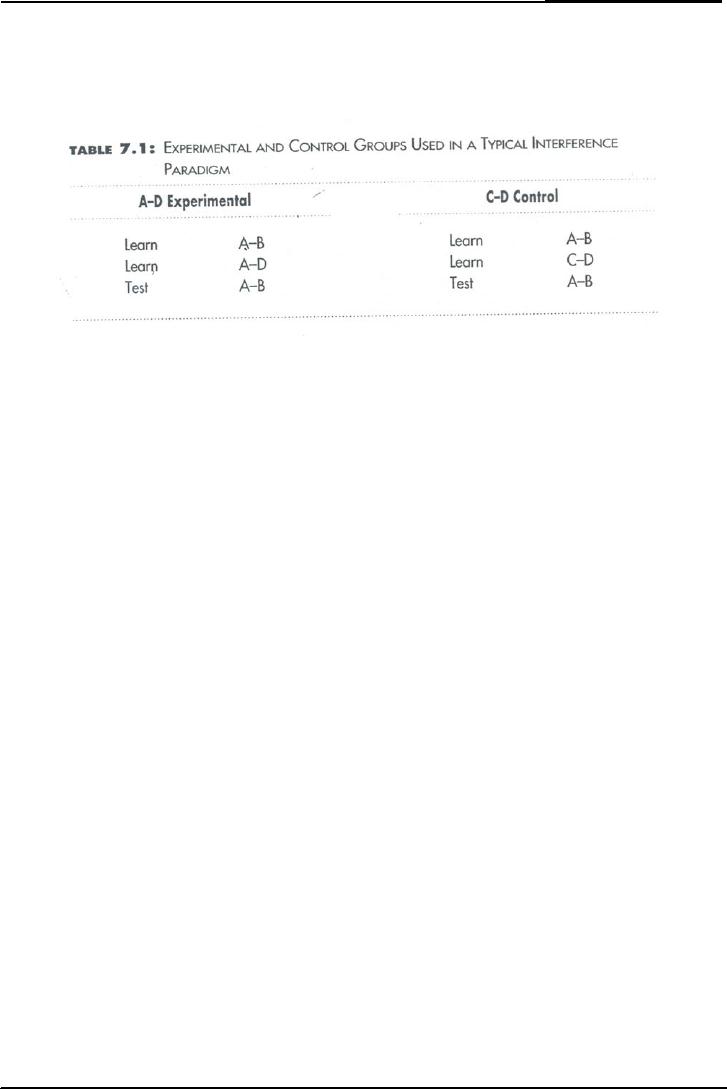 |
Memory:Interference, Historical Memories, Recall versus Recognition |
| << Memory:Interference, The Critical Assumption, Limited capacity |
| Memory:Are forgotten memories lost forever? >> |

Cognitive
Psychology PSY 504
VU
Lesson
31
Memory
Interference
The
fan effect is the name
given to this increase in
reaction time related to an
increase in the
number
of facts associated with a
concept. It is so named because
the increase in reaction
time
is
related to an increase in the
fan of facts emanating from
the network representation of
the
concept.
The term conveys the
fact that additional
information about a concept
interferes with
memory
for a particular piece of
information. Interference affects a
wider range of measures
than
just
recognition time. Fan effect
is reserved for interference
effects as measured by reaction
time.
Historical
Memories
Lewis
& Anderson (1976) investigated
whether he fan effect could
be obtained with material
the
subject
knew before the experiment.
They had subjects learned
fantasy figures for
example,
Napoleon
Bonaparte was from India.
Subjects studied 0-4 fantasy
facts about each public
figure.
After
learning these facts they
proceeded to a recognition-test phase. In
this phase they
saw
three
types of sentences:
Fantasy
world statements, true
statements, and false
statements like
1)
Statements they had studied
in the experiment
2)
True facts about the
public figurers (such as
napoleon bonapartae was an
emperor);
3)
Statements about the public
figure that was false
both in the experimental
fantasy world
and
in the real world.
Subjects
had to respond to the first
two types of facts as true
and to the last type as
false.
Results
Subjects
responded much faster to
actual truths than to
experimental truths. The
advantage of
the
actual truths can be
explained, because these
true facts would be much
more strongly
encoded
in memory than the fantasy
facts because of greater
prior exposure. The more
fantasy
facts
one learned about a person,
the longer it took them to
recognize something they
already
knew
about the person; Napoleon
was an emperor.
Interference
and Retention
Now
we will consider what
happens as these interfering
effects get more
extreme-either because
the
to-be-recalled fact is very
weak or because the
interference is very
strong.
There
is evidence that the subject
simply fails to remember the
information under both
conditions.
Results
showing such failures of
memory have traditionally
been obtained with
paired-associate
material,
although similar results
have been obtained with
other material.
Experiment
In
a typical interference experiment,
two critical groups were
defined.
The
A-D experimental group
learns two lists of paired
associates,
The
first list is List
A-B: cat-43 and
house-61
And
second list is List
A-D: cat-82 and
house-37
The
C-D control group also
first studies the A-B
list, but then studies a
different second
list,
List
C-D is bone-82
and cup-37, which does
not contain the same
stimuli as the first
list.
After
learning their respective
second lists, both groups
are rested for their
memory of their first
list,
in both cases the A-B
list.
92

Cognitive
Psychology PSY 504
VU
Results
In
general, the A-D group
does not do as well as the
C-D group with respect to
both rate of
learning
of the second list and
retention of the original
A-B list.
The
results are presented in
following figure.
Implications
The
implication is that failure to
recall is the extreme case
of a long retrieval time.
Thus, it is not
the
case that the forgotten
information is not in memory,
but rather that it is in
memory but is too
weak
to be activated in the face of
interference from other
associations. Paired associate
memory
is
too weak to recall.
Forgetting
is not actual loss of
information but rather loss
of ability to activate that
information.
Recall
versus Recognition
Consistent
with the hypothesis that
there exists in memory
information that we can not
recall is
the
fact that we can recognize
many things we cannot
recall. This phenomenon
suggests that
information
can be in memory even though
it cannot be activated in the
recall test situation.
The
memory
network analysis makes clear
the reason that recognition
often works even when
recall
fails.
So, recognition is generally
better than recall. For
example if there is a
question
Who
invented the lenses we use
in spectacles?
Then
a huge fan of information
networks becomes active. We
recall a lot of information
that is
related
to glasses or spectacles.
For
example someone mention
Ibn-al Haitham invented the
lenses we use in spectacles. If
we
have
listened this before now,
then we can recall this
answer because of strong
enough
information.
So, Joint activation helps
the second statement.
There
are many other
possibilities. If with this
question (Who invented the
lenses we use in
spectacles?
we have some options like,
Michael, Ibne Batota,
Albaroni and Ibn Al Haitham.
Now
these
options interfere with our
information. And we become confuse.
But because of our links
or
network
we can recall correct
information. Like spectacles
were invented by Muslim
scientist so,
Michael
could not be answer.
So,
recognition is typically better
than recall because a
recognition test typically
provides more
sources
for activating memory.
Recognition test is better
than recall test. Tip of
the tongue is
happened
in recall not in
recognition.
For
example, if you see a man
you say you have
seen him before. So you
can recognize him.
But
you
are not recalling his
name.
In
our daily life, in our
exams, in any test or in
other situation we think
recognition is our friend
and
recall
is not much friendly.
93

Cognitive
Psychology PSY 504
VU
Another
example is if someone asks
you when Baber came in
Hindustan and invaded
Hindustan.
The
chances are we could not
recall. If someone gives us
some options like, 712,
789, 1566 and
1020
with question. Then it
becomes easy to recognize
when Baber invaded
India.
So
the conclusion of all that
is recognition is a better and
easiest task than
recall.
94
Table of Contents:
- INTRODUCTION:Historical Background
- THE INFORMATION PROCESSING APPROACH
- COGNITIVE NEUROPSYCHOLOGY:Brains of Dead People, The Neuron
- COGNITIVE NEUROPSYCHOLOGY (CONTINUED):The Eye, The visual pathway
- COGNITIVE PSYCHOLOGY (CONTINUED):Hubel & Wiesel, Sensory Memory
- VISUAL SENSORY MEMORY EXPERIMENTS (CONTINUED):Psychological Time
- ATTENTION:Single-mindedness, In Shadowing Paradigm, Attention and meaning
- ATTENTION (continued):Implications, Treismanís Model, Normanís Model
- ATTENTION (continued):Capacity Models, Arousal, Multimode Theory
- ATTENTION:Subsidiary Task, Capacity Theory, Reaction Time & Accuracy, Implications
- RECAP OF LAST LESSONS:AUTOMATICITY, Automatic Processing
- AUTOMATICITY (continued):Experiment, Implications, Task interference
- AUTOMATICITY (continued):Predicting flight performance, Thought suppression
- PATTERN RECOGNITION:Template Matching Models, Human flexibility
- PATTERN RECOGNITION:Implications, Phonemes, Voicing, Place of articulation
- PATTERN RECOGNITION (continued):Adaptation paradigm
- PATTERN RECOGNITION (continued):Gestalt Theory of Perception
- PATTERN RECOGNITION (continued):Queen Elizabethís vase, Palmer (1977)
- OBJECT PERCEPTION (continued):Segmentation, Recognition of object
- ATTENTION & PATTERN RECOGNITION:Word Superiority Effect
- PATTERN RECOGNITION (CONTINUED):Neural Networks, Patterns of connections
- PATTERN RECOGNITION (CONTINUED):Effects of Sentence Context
- MEMORY:Short Term Working Memory, Atkinson & Shiffrin Model
- MEMORY:Rate of forgetting, Size of memory set
- Memory:Activation in a network, Magic number 7, Chunking
- Memory:Chunking, Individual differences in chunking
- MEMORY:THE NATURE OF FORGETTING, Release from PI, Central Executive
- Memory:Atkinson & Shiffrin Model, Long Term Memory, Different kinds of LTM
- Memory:Spread of Activation, Associative Priming, Implications, More Priming
- Memory:Interference, The Critical Assumption, Limited capacity
- Memory:Interference, Historical Memories, Recall versus Recognition
- Memory:Are forgotten memories lost forever?
- Memory:Recognition of lost memories, Representation of knowledge
- Memory:Benefits of Categorization, Levels of Categories
- Memory:Prototype, Rosch and Colleagues, Experiments of Stephen Read
- Memory:Schema Theory, A European Solution, Generalization hierarchies
- Memory:Superset Schemas, Part hierarchy, Slots Have More Schemas
- MEMORY:Representation of knowledge (continued), Memory for stories
- Memory:Representation of knowledge, PQ4R Method, Elaboration
- Memory:Study Methods, Analyze Story Structure, Use Multiple Modalities
- Memory:Mental Imagery, More evidence, Kosslyn yet again, Image Comparison
- Mental Imagery:Eidetic Imagery, Eidetic Psychotherapy, Hot and cold imagery
- Language and thought:Productivity & Regularity, Linguistic Intuition
- Cognitive development:Assimilation, Accommodation, Stage Theory
- Cognitive Development:Gender Identity, Learning Mathematics, Sensory Memory